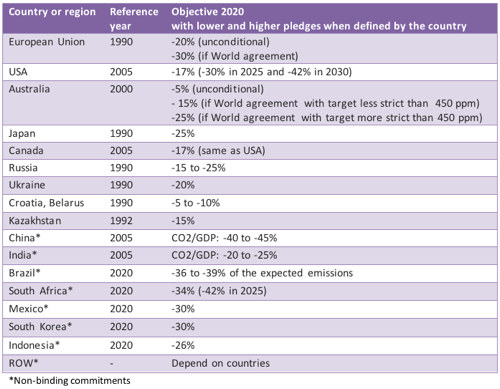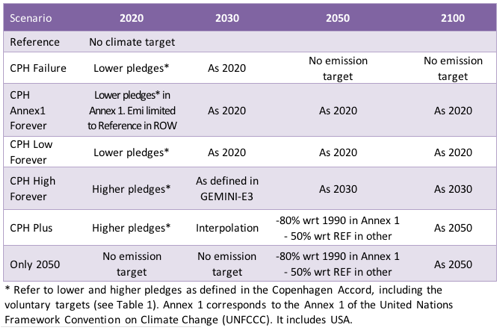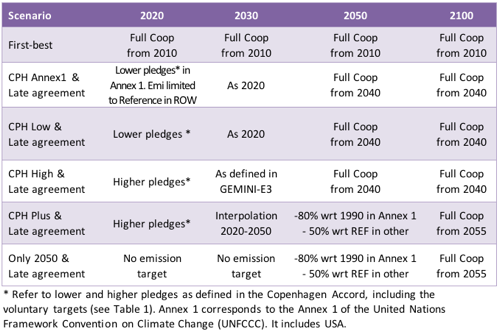Scenario Choices
Reminder of the project goals and of the first phase (COP15)
The
objective of SynsCOP15 is to analyse the possible effects on climate,
economies and energy systems of countries of different international
environmental agreements that might emerge - or not - from the negotiations
held before and after the 15th Conference of the Parties in Copenhagen.
In the first
phase of the project,
several scenarios have been evaluated to simulate different arrangements
proposed before COP15 in Copenhagen, representing both first-best - full
cooperation amongst all countries, and second-best scenarios - such as a
complete failure in negotiations, an agreement within subgroups of countries
(OECD, OECD+Russia, G20).
One of the
conclusions is that the
long term 2°C climate target is feasible in all cases whatever countries do
before 2030, but assuming that a World Climate Agreement is implemented from
2030 and for the rest of the century. This outcome would require much higher
and faster mitigation efforts after 2030 in the cases where almost nothing is
done before 2030, and such rapid and high efforts might be unrealistic. For
example, in the worst case, the energy-system must be CO2-free almost 10 years
earlier than in a case where an international agreement scenario is quickly
implemented. In terms of macro-economic impacts, welfare losses more important
in Europe and in energy exporting countries, but they are possibly reduced by
the selling of carbon permits, for example by Russia.
Phase-II Scenarios (COP16)
The scenarios analysed in the second phase of the project aim the following objectives:
- To evaluate the long-term consequences of different strategies, including the pledges proposed in the Copenhagen Accord, as well as several threat scenarios where limited or even no long-term agreement is reached. This analysis is done with TIAM.
- To study the macro-economic impacts of the different 2020-2030 policy proposals, including the impacts of emission permit trading between countries with enforcing emission targets, and also between countries with and without enforcing targets. This analysis is done with GEMINI-E3.
- To refine the estimation of the regional climatic impacts of the different strategies. This analysis is done with GENIE.
- To study long-term allocation of quotas to reach the 2°C target (burden-sharing).
Table 1 presents the national pledges, with lower and higher values in some cases, as proposed by the countries in the Copenhagen Accord. Table 2 and 3 summarize the scenarios modelled in this phase of the project.


Other assumptions:
- In the case of pledges applied to countries belonging to regions of TIAM (eg. South Africa is included in the regional called Africa in TIAM), ratios have been used to define the emission target of the region as modelled in TIAM.
- In TIAM, trade of carbon permits is limited to 10% in 2020 and 20% in 2030 and later of the required emission reduction of each country, including the voluntary emission reductions.

Other assumptions:
- The long-term climate target is 2°C in 2100, with possible overshooting of the target before 2100. All countries agree and cooperate from 2010, 2040 or 2055, depending on the scenarios
- Trade of carbon permits is limited to 10% in 2020 and 20% in 2030 and later of the required emission reduction of each country, including the voluntary emission reductions, when only a partial climate agreement is implemented. As soon as full cooperation between all countries is assumed, starting in 2010, 2040 or 2055 depending on the scenarios, trade of carbon permits is unlimited.

